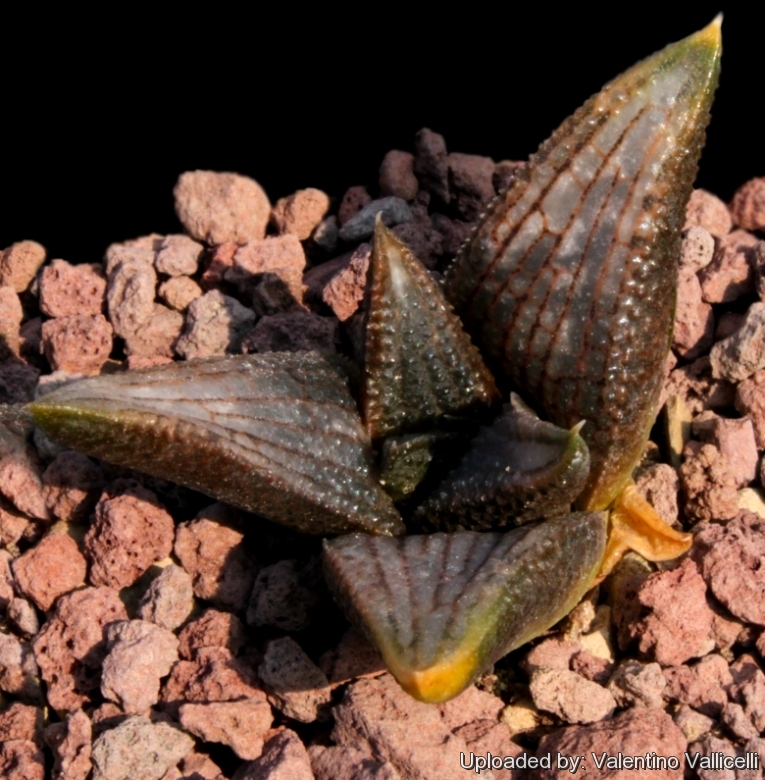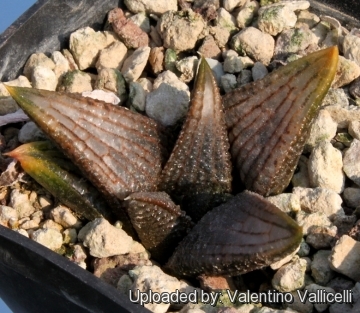
Haworthia koelmaniorum Photo by: Valentino Vallicelli
Origin and Habitat: Haworthia koelmaniorumSN|13400]]SN|13400]] is the most northern record species in the genus, it occurs around Groblersdal and Loskop Dam in Transvaal.
Type locality: Near Globlersdal.
Altitude: It occurs at an altitude of about 900-1200 metres above sea level.
Habitat: Arid Bushveld (savannah) and grassveld (grassland) biomes, mostly on quartzites and sandstone outcrops and ridges, both on exposed places or on the shade of bushes and grasses. The plants always grow in deep cavities between fixed rocks, usually tightly wedged into the ground. The rosettes are normally flush and well camouflaged with the soil surface resembling dead leaves in, colour, and texture, rendering the plants extremely cryptic. They are brownish-green in colour, sometimes taking on a reddish or greyish tint with age. These plants are difficult to spot in their natural habitat. In times of severe drought, the whole above-ground portion of these plants can shrink and be covered by dust and dead leaves, but the swollen succulent roots remains alive. Haworthia koelmaniorumSN|13400]]SN|13400]] thrives in a fire driven ecological system. This often results in losses of Haworthias and it shrinks the sizes of populations confining them largely to areas protected by the biggest rocks. However fires have little effect on these plants and improve the conditions for the germination of seeds in summers directly after a winter grass fire.
The burning of dry grass frequently damages the plants, usually destroying the tissue at the tip of the leaves. Only large robust plants seem capable of flowering under these conditions. Habitats are degraded, via the exclusion of fires, by livestock and expansion of rural settlements.
Synonyms:
See all synonyms of Haworthia koelmaniorum
Description: Haworthia koelmaniorumSN|13400]]SN|13400]] is a quite unusual slowly growing species. It is characterized by dark brownish-green leaves, with thick leathery, nodular skin on them, that somewhat resembles a reptile's skin. It is quite variable and in most colonies typical long leaved plants as well as some shorter leaved examples are found. The latter are often indistinguishable in appearance from typical variety mcmurtryi. It is a very popular and demanded species, sought after by collectors.
Similar species: It looks a lot like its closer relative Haworthia limifoliaSN|14482]]SN|21354]], at least in terms of roughness and warts, but not linearly stippled, and it is much slower growing. It is also related to Haworthia venosaSN|14464]]SN|14464]] and somehow to Haworthia tessellataSN|21354]]SN|14482]].
Habit: Usually solitary when growing in exposed places, but in deep shade tend to offset, forming clumps, suckering plants are valuable.
Rosettes: Stemless, reaching a diameter of 5-10 cm
Leaves: 14-20, ovate, 7 cm long, 2 cm broad, opaque, dark brownish-green, tan, reddish or grey or some thing in between (as opposed to greenish like H. limnifolia), somewhat recurved, scabrid with small raised tubercles, margins and keel with small spines.
Inflorescence: Slender, wiry to 35 cm tall. Haworthia koelmaniorumSN|13400]]SN|13400]] often grows more than one flower stem in a given flowering season usually 2 – 3. These are frequently produced over a period of a few weeks.
Flowers: 10-15, slender, tepal-tips revolute.
Subspecies, varieties, forms and cultivars of plants belonging to the Haworthia koelmaniorum group
 Haworthia koelmaniorum Oberm. & D.S.Hardy: ia a slowly growing species characterized by dark brownish-green, leaves, with thick, leathery, nodular skin on them, that somewhat resembles a reptile's skin. Distribution: around Groblersdal and Loskop Dam in Transvaal.
Haworthia koelmaniorum Oberm. & D.S.Hardy: ia a slowly growing species characterized by dark brownish-green, leaves, with thick, leathery, nodular skin on them, that somewhat resembles a reptile's skin. Distribution: around Groblersdal and Loskop Dam in Transvaal. Haworthia koelmaniorum var. mcmurtryi (C.L.Scott) M.B.Bayer: It is smaller in size with more prominent surface markings. Leaves are shorter, more squatter and can be obscurely windowed. Distribution: endemic to the highveld areas of Mpumalanga Province.
Haworthia koelmaniorum var. mcmurtryi (C.L.Scott) M.B.Bayer: It is smaller in size with more prominent surface markings. Leaves are shorter, more squatter and can be obscurely windowed. Distribution: endemic to the highveld areas of Mpumalanga Province.
Bibliography: Major refetrences and further lectures
1) Urs Eggli “Illustrated Handbook of Succulent Plants: Monocotyledons” Springer, 01/gen/2001
2) M. B. Bayer “The new Haworthia handbook” National Botanic Gardens of South Africa, 1982
3) John Pilbeam “Haworthia and Astroloba: A Collector's Guide” 1983
4) Stuart Max Walters, James Cullen “The European Garden Flora: Pteridophyta, Gymnospermae, Angiospermae” Cambridge University Press, 1986
5) David Hardy, Anita Fabian, Gerrit Germishuizen “Succulents of the Transvaal” Southern Book Publishers, 1992
6) Keith Grantham, Paul Klaassen “The plantfinder's guide to cacti & other succulents” Timber Press, 18/mag/1999
7) E. Retief, P. P. J. Herman “Plants of the northern provinces of South Africa: keys and diagnostic characters” National Botanical Institute, 1997
8) http://haworthia-gasteria.blogspot.it/2008/11/haworthia-koelmaniorum.html
9) Bruce Bayer. "Haworthia Revisited. A revision of the Genus", Umdaus Press, Hatfield, Pretoria, 1999
10) P.T.A. Bosch. "The geological pedalogical and climatical influence on variety generation in Haworthia koelmaniorum variety koelmaniorum and H. koelmaniorum variety mcmurtryi." Aloe 41: 2 and 3, 2004
11) Charles Craib. "The autecology and status of Haworthia koelmaniorum variety mcmurtryi." Aloe 44: 1, 2007
12) Charles Craib. "An evaluation of the two varieties of Haworthia koelmaniorum and a study of the plants in the western part of their distribution range." In. ed. (Full details will be supplied when the paper is published).
13) Amelia Obermeyer. Haworthia koelmaniorum. in: The Flowering Plants of Africa, Volume 38, Plate 1502, 1967, Botanical Research Institute, Pretoria.
14) Charles L. Scott. The Genus Haworthia a taxonomic revision. in : Aloe Books, Johannesburg, 1985
15) Pemroock seeds and plants newsletter September and October 2008
 Haworthia koelmaniorum Photo by: Valentino Vallicelli
Haworthia koelmaniorum Photo by: Valentino VallicelliSend a photo of this plant.The gallery now contains thousands of pictures, however it is possible to do even more. We are, of course, seeking photos of species not yet shown in the gallery but not only that, we are also looking for better pictures than those already present.
Read More... Cultivation and Propagation: Haworthia koelmaniorumSN|13400]]SN|13400]] are of relatively easy cultivation, but very slow-growing. Haworthias are winter growers and are dormant in the hottest summer months.
Soil: They are tolerant of a wide range of soils and habitats, but prefer a very porous potting mix to increase drainage. A non-acid soil is ideal. You can grow a plant in a small cm pot for years and have perfectly happy plants. For best results, use a shallow pot.
Exposition: The plant needs light shade to shade, but will take full sun part of the day. (with some sun exposure the leaf develops a nice reddish tint and remains compact).
Watering: During the hot summer months, the soil should be kept moist but not overly wet. During the winter months, water only when the soil becomes completely dry. Wet soil quickly causes root and stem rot, especially during chilly winter months. No water should ever be allowed to stand around the roots. Low ambient humidity is always needed.
Fertilization: The plants are fertilized only once during the growing season with a balanced fertilizer diluted to ½ the recommended strength.
Hardiness: Although the plant will survive mild frost if kept dry (hardy as low as -5° C) it should be protected from severe cold and prolonged frost conditions.
Rot: Rot is only a minor problem with Haworthia if the plants are watered and “aired” correctly. If they are not, fungicides won't help all that much. Care must be given in watering, keeping them warm and wet while growing, and cooler and dry when dormant.
Remarks: Haworthias are best planted in a shaded and airy part of the greenhouse, and not too close to the glass roof or sides of the house as the plants can overheat during hot spells.
Propagation: Haworthia are easily propagated by the removal of offshoots or by leaf cuttings in spring or summer. To propagate by leaf cuttings, remove a leaf and let it lie for about one month, giving the wound time to heal. Then lay the leaf on its side with the basal part buried in the soil. This leaf should root within a month or two, and small plants will form at the leaf base. They can also be grown from seed.











